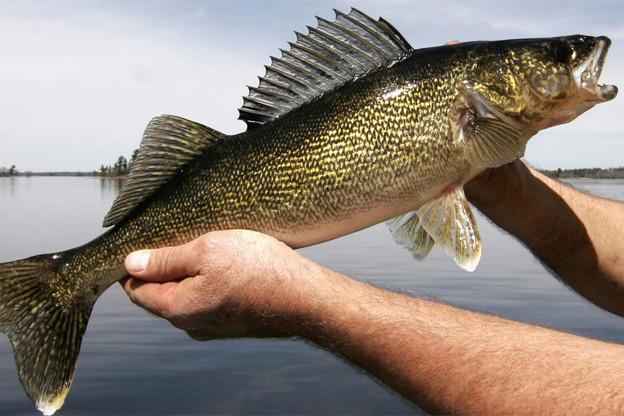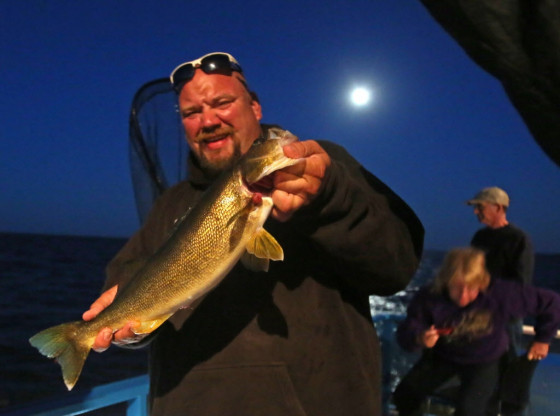

Consider the walleye
See the updates below.
I swear to you that I never in my blogging life thought I’d write a story that had walleye in the title. But a whole industry has grown up around a fish that is, in general, a snore to catch, and it must be saved. But they taste so good, a walleye fisherman said to me once. In a moment that I am not especially proud of, but will admit to, I replied, Yes, so do chickens, but that does not make catching them a sport.
Well, we probably don’t have many walleye angler readers here at LeftMN, anyway.
What makes this issue so fascinating is its capacity to enrage a segment of the population and move the political leaders in the state to consider a special legislative session, as though they can legislate walleye into existence. Or something.
The walleye season is closing on Lake Mille Lacs tonight, August 3rd, at midnight. How do you know people are fishing specifically for walleye? They’re sitting hunched over and motionless in a deep-hulled boat with a big outboard, usually at night.
Parenthetically, the resort owners and the fishing guides around the lake are saying, Hey, there are plenty of other kinds of fish to catch. Don’t stay away! And I would add, They’re more fun to catch than your average wet-sock-on-the-line walleye, too!
If you’re just into walleye fishing for the taste, sell your fancy fishing boat and buy fresh walleye at the grocery story every week for the rest of your life.
I am being facetious and hyperbolic here — I hope you all know that — but not entirely so.
I read somewhere than a catch and release season was proposed, but that was rejected. Catch and release for bait-caught fish is a loser, anyway. Hooking mortality for bait-caught fish is especially high; anglers would be tossing back a lot of mortally-wounded fish.
This is probably why slot limits on the lake, intended to make anglers return the reproduction-sized fish to the lake, did not work very well in preserving the population. In fact, it may result in more dead fish, if an angler catches, mortally wounds, and then “releases” many fish of the forbidden size.
It did keep more fisherfolk on the lake, though.
Correction & Amplification: According to this Strib article by Mary Lynn Smith, catch and release angling for walleye may happen next year on Mille Lacs.
The Pat Pfeifer story at the first link also includes this:
On Sunday, Landwehr and fisheries section chief Don Pereira said the sport fishermen’s allotment already has been exceeded by at least 2,000 pounds. Not included is 750 pounds of walleye that succumbed after a recent catch-and-release tournament and an unknown number that will die as hooking and releasing continues through Dec. 1.
And it’s possible that the problem is not reproduction, anyway. It could be reduced forage fish for the walleye, such as tullibees. Tullibees thrive in colder water; Mille Lacs is a shallow lake, more subject to warming from climate change. Any middle schooler can tell you that forage species control predator population. Or, it could be predation of walleye fry by adult walleyes (!) or pike. Sadly, the walleyes, like the Donner Party, may have turned to cannibalism because there aren’t enough tullibees.
Nobody really knows, but in the meantime, let’s blame the Indians. LeftMN contributor Jeff has already written some about that. From the Strib article at the first link in the paragraph:
In the bait shops and bars, fishing docks and resorts that make up the world of Mille Lacs fishing, the collapse of the lake’s walleye fishery has inflamed age-old tensions between white sport anglers and local Indian bands who share the lake. (You can read more about the same old tensions in a Washington Post article from 1998, here.)
From the same Strib article though:
Eight Indian bands have treaty rights stemming from 1837 to net walleye in Mille Lacs, and this year they netted 10,140 pounds of their 11,400 limit, according to the Department of Natural Resources. State scientists say the netting cannot be blamed for the lake’s vanishing walleye population.
It is incomprehensible to some people that Indians have any rights left at all. It is kind of surprising, isn’t it?
Among the people who were surprised were members of the Save Lake Mille Lacs Association:
On July 29, 1837 the United States entered into a treaty with several bands of Chippewa Indians. Under the terms of the treaty the Indians ceded the northern one-third of present-day Wisconsin and 3,061,501 acres of land in what would later become Minnesota to the United States, and the United States guaranteed to the Indians certain hunting, fishing, and gathering rights on the ceded land.
In August 1990 the Mille Lacs Band of Chippewa Indians and several of its members filed suit in the Federal District Court for the District of Minnesota against the State of Minnesota, the Minnesota Department of Natural Resources, and various state officers seeking, among other things, a declaratory judgment that they retained their usufructuary rights (the right to hunt, fish, and gather on the ceded lands) under the 1837 treaty, and an injunction to prevent the State’s interference with those rights. The United States intervened as a plaintiff in the suit; nine counties and six private landowners intervened as defendants. The lawsuit involved treaty rights on lands located in Crow Wing, Aitkin, Pine, Chisago, Anoka, Isanti, Kanabec, Mille Lacs, Sherburne, Benton, and Morrison counties. Included in this tract is Lake Mille Lacs, Minnesota’s premier walleye fishing lake.
The District Court bifurcated the case into two phases. Phase I of the litigation would determine whether, and to what extent, the Mille Lacs Band retained any usufructuary rights under the 1837 treaty, while Phase II would determine the validity of particular state measures regulating any retained rights. The State of Minnesota argued that the Indians lost these rights through a presidential executive order in 1850, an 1855 treaty, and the admission of Minnesota into the union in 1858.
A proposed out-of-court agreement was reached between the Lake Mille Lacs Band and the State of Minnesota by 1992 to resolve the issue. The Save Lake Mille Lacs Association (SLMLA), however, believed that the case should instead be settled [litigated, that is, ed.] in Federal court. The SLMLA and others apparently were successful in getting this proposed agreement thrown out, and the case proceeded to trial.
One of the surprised leaders of the Save Lake Mille Lacs Association was Bud Grant.
Because you know how this came out, don’t you? From the link:
After a bench trial on the Phase I issues District Court judge Diana Murphy ruled on August 24, 1994 that the Mille Lacs Band did in fact retain its rights to hunt, fish, and gather on the ceded lands, as guaranteed by the 1837 treaty. Several resource allocation and regulation issues related to Phase II of the litigation were resolved in a final order issued in 1997. Judge Murphy’s decision was appealed to the 8th circuit U.S. Court of Appeals, where it was affirmed in 1997. The case was then appealed to the United States Supreme Court, which affirmed the judgement of the 8th Circuit Court of Appeals in an opinion dated March 24, 1999.
The sovereign Ojibwe nations have the right to net fish — but they apparently aren’t going to next year, anyway — and the DNR has concluded they aren’t to blame, but what the heck, they’re Indians, right?
Update: A walleye is buried at sea.

A walleye is buried at sea – David Joles photo
Here’s a photo of a Mille Lacs caught walleye in the Pat Pfeifer story linked above. The cutline says that the fish was “released.” But it was really buried at sea. It looks like the fish’s guts (or maybe a piece of nightcrawler from the fish’s stomach) are hanging out of its gills, probably because it swallowed the live bait (see the remarks about live bait hooking mortality above) and everything was pulled out when the hook was extracted. To add insult to injury, the guide holding the fish has his fingers stuffed up the fish’s gills, a genuine no-no if you want the fish to survive.
The sports angler harvest numbers are completely skewed and underestimated by practices like this. The fish was “released,” so it doesn’t count.
Thanks for your feedback. If we like what you have to say, it may appear in a future post of reader reactions.

